The G2 Grease Guard Rooftop Defense
Systems protect your roofing system from the damaging
effects of corrosive grease, oil, chemicals or fluids
that are discharged during routine manufacturing operations.
Petroleum-based oils, motor oil and hydraulic fluid are
used in numerous types of manufacturing facilities.
Oil- and chemical-laden air is vented from the facility
and deposited onto the roof via exhaust fans or piped
discharge applications. The G2 Grease Guard protects
building owners from costly roof repairs, voided roof
warranties, unnecessary fire hazards and excessive
liability claims. Just a few of the manufacturing
effluents that can substantially damage unprotected roofing
systems are shown below.
|
|
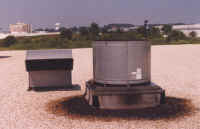
|
Before |
| |
|
After
|
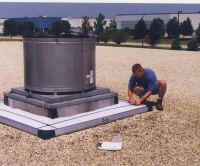
|
|
- Helps you comply with 40 CFR 122.26 (1998) when used as
a Best Management Practice in your Storm Water Pollution
Prevention Plan.
- Prevents costly roof repairs and voided roof warranties
- Reduces fire hazards and excessive liabilities.
- Listed by Underwriters Laboratories Inc. for
effectiveness and safety.
- Helps you comply with OSHA, NFPA and EPA regulations.
|
| Rooftop Defense Systems Work |
|
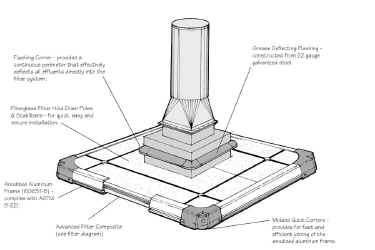
|
|
Filter Diagram
|
|
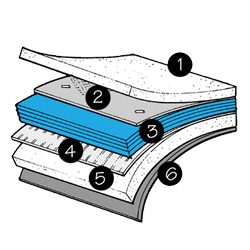
|
- Top Pre-Filter - a
pass-thru, noncombustible, self-extinguishing filter
constructed from an open cross section polymer.
- Transfer Layer -
constructed from polyolefin fiber. Designed for quick
transfer of oil-based fluids to the absorption layers, while
repelling rainwater. UV stability protects the
absorption layers from damaging sun rays.
- Advanced Filter
Composite - constructed from an engineered open cell
polyolefin fabric. Over 100 layers of absorbent
microfibers wick and contain oil based fluids, while
repelling rainwater. Absorption capacity is up to 78
fluid ounces per square foot.
|
- Barrier Layer - constructed from a closed cell
polymeric blend that provides a leak proof barrier.
- Bottom Layer - an airflow layer constructed from
an open cross section polymer. This layer supports the
absorption and security layers while allowing air to
circulate throughout the entire filter system.
- Fire Shield - a fire-proof barrier that protects
the roof & building from any potential exhaust system
fire hazard.
|
|
Sizing
|
- Measure the area where grease actually drips, splashes
and sprays (A) around the exhaust equipment. Disregard
any areas where gravity moves the grease (B.)
- Add 30" to length (A) and width (A) from Step 1 to
determine the closest G2 Grease Guard size needed.
- For example, if area (A) is 50" x 58", add
30" to each measurement to get 80" x 88" (C).
Use the 80" x 88" (C) to select a 90" square
unit.
|
|
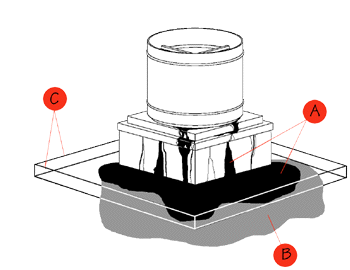
|
|
Installation
|
- Assemble the frame around the problem area. The
frame system consists of the patented "Quick
Corners" (A) and the heavy duty aluminum frames (B),
which bolt together using an allen wrench (C) (included) as
shown below.
- Measure and draw the exhaust equipment cut-out area on
the filters. Be sure to measure for a snug fit.
Use scissors to cut the filter materials (D). Once
filter materials are cut, tuck into frame around exhaust
equipment.
- Screw the grease deflecting flashing to the exhaust
equipment curb (E) on all sides. The flashing directs
the grease directly into the absorbent filter system.
|
|
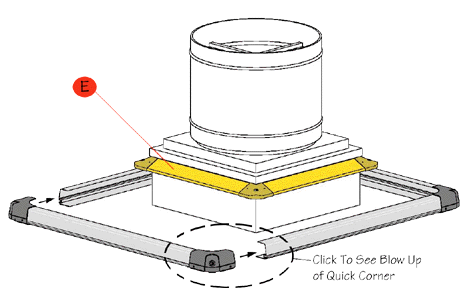
|
|
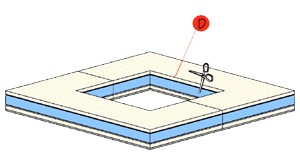
|
|
Part #
|
Dimensions (LxWxH)
|
Shipping
|
Weight
|
|
| Part #8800 |
48" x 48" x 4" |
Ships in 2 boxes
|
42 lbs.
|
|
| Part #8801 |
60" x 60" x 4" |
Ships in 2 boxes
|
60 lbs.
|
|
| Part #8802 |
72" x 72" x 4" |
Ships in 3 boxes
|
79 lbs.
|
|
| Part #8803 |
72" x 108" x 4" |
Ships in 4 boxes
|
115 lbs.
|
|
| Part #8804 |
90" x 90" x 4" |
Ships in 4 boxes
|
120 lbs.
|
|
| Part #8805 |
108" x 108" x 4" |
Ships in 5 boxes
|
142 lbs.
|
|
| Part #8806 |
120" x 120" x 4" |
Ships in 5 boxes
|
180 lbs.
|
|
| Part #8807 |
144" x 144" x 4" |
Ships in 9 boxes
|
250 lbs.
|
|
|
Other Stock Sizes Available.
|
*COMPLETE SYSTEM INCLUDES: Aluminum frame, Quick
Corners, allen wrench, flashing and screws, Hold-down Grid, top
Pre-filter, Advanced Filter Composite (which consists of Transfer Media,
Absorbent Core, and Polymeric Barrier), Bottom Airflow Filter, Fire
Shield, instructions.
**U.S. Patent Nos. 5,196,040 and 5,318,607.
Other Patents Pending.
|